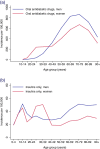No increase in new users of blood glucose-lowering drugs in Norway 2006-2011: a nationwide prescription database study
- PMID: 24886413
- PMCID: PMC4045953
- DOI: 10.1186/1471-2458-14-520
No increase in new users of blood glucose-lowering drugs in Norway 2006-2011: a nationwide prescription database study
Abstract
Background: National estimates for the occurrence of diabetes are difficult to obtain, particularly time trends in incidence. The aim was to describe time trends in prevalent and incident use of blood glucose-lowering drugs by age group and gender in Norway during 2005-2011.
Methods: Data were obtained from the nationwide Norwegian Prescription Database. We defined prevalent users of "insulins only" as individuals having no oral antidiabetic drugs (OAD) dispensed from a pharmacy during the previous 24 months or in the subsequent 12 months. Incident users had no blood glucose-lowering drugs dispensed in the previous 24 months; incident "insulins only" users also had no OAD in the subsequent 12 months.
Results: In 2011, 3.2% of the population had blood glucose-lowering drugs dispensed, and the incidence rate was 313 per 100,000 person years. The prevalence of OAD use increased from 1.8% in 2005 to 2.4% in 2011; however a decreasing trend in incidence of OAD use was observed, particularly in those aged 70 years and older. In 2010, 0.64% of the population had insulins only dispensed, with an overall incidence rate in the total population of 33 per 100,000 person years which was stable over time.
Conclusions: In this nationwide study, we found that although the prevalent use of OAD had increased in recent years, incident use was stable or had decreased. This may indicate that the increase in diabetes occurrence in Norway is levelling off, at least temporarily.
Figures





References
-
- Morton LM, Cahill J, Hartge P. Reporting participation in epidemiologic studies: a survey of practice. Am J Epidemiol. 2006;163:197–203. - PubMed
Publication types
MeSH terms
Substances
LinkOut - more resources
Full Text Sources
Other Literature Sources
Medical

